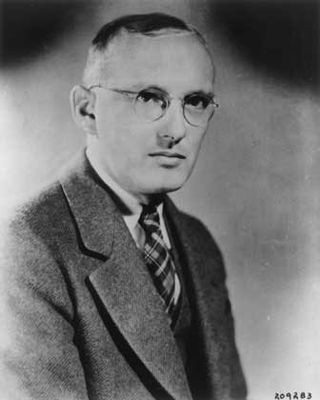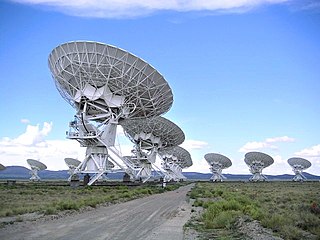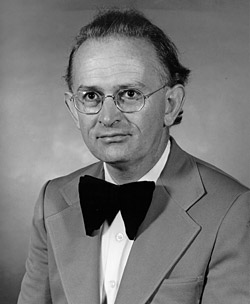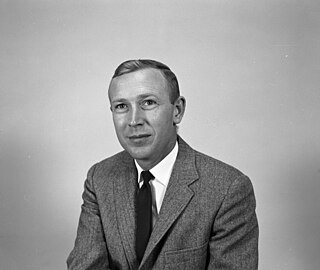
Frank Donald Drake was an American astrophysicist and astrobiologist.

Karl Guthe Jansky was an American physicist and radio engineer who in April 1933 first announced his discovery of radio waves emanating from the Milky Way in the constellation Sagittarius. He is considered one of the founding figures of radio astronomy.

The Karl G. Jansky Very Large Array (VLA) is a centimeter-wavelength radio astronomy observatory in the southwestern United States. It lies in central New Mexico on the Plains of San Agustin, between the towns of Magdalena and Datil, approximately 50 miles (80 km) west of Socorro. The VLA comprises twenty-eight 25-meter radio telescopes deployed in a Y-shaped array and all the equipment, instrumentation, and computing power to function as an interferometer. Each of the massive telescopes is mounted on double parallel railroad tracks, so the radius and density of the array can be transformed to adjust the balance between its angular resolution and its surface brightness sensitivity. Astronomers using the VLA have made key observations of black holes and protoplanetary disks around young stars, discovered magnetic filaments and traced complex gas motions at the Milky Way's center, probed the Universe's cosmological parameters, and provided new knowledge about the physical mechanisms that produce radio emission.

The National Radio Astronomy Observatory (NRAO) is a federally funded research and development center of the United States National Science Foundation operated under cooperative agreement by Associated Universities, Inc. for the purpose of radio astronomy. NRAO designs, builds, and operates its own high-sensitivity radio telescopes for use by scientists around the world.

The Robert C. Byrd Green Bank Telescope (GBT) in Green Bank, West Virginia, US is the world's largest fully steerable radio telescope, surpassing the Effelsberg 100-m Radio Telescope in Germany. The Green Bank site was part of the National Radio Astronomy Observatory (NRAO) until September 30, 2016. Since October 1, 2016, the telescope has been operated by the independent Green Bank Observatory. The telescope's name honors the late Senator Robert C. Byrd who represented West Virginia and who pushed the funding of the telescope through Congress.
Green Bank is a census-designated place in Pocahontas County in West Virginia's Potomac Highlands inside the Allegheny Mountain Range. Green Bank is located along WV 28. Green Bank is home to the Green Bank Observatory and is also close to the Snowshoe Mountain ski resort. As of the 2020 census, its population was 141.

The Very Long Baseline Array (VLBA) is a system of ten radio telescopes which are operated remotely from their Array Operations Center located in Socorro, New Mexico, as a part of the National Radio Astronomy Observatory (NRAO). These ten radio antennas work together as an array that forms the longest system in the world that uses very long baseline interferometry. The longest baseline available in this interferometer is about 8,611 kilometers (5,351 mi).

The Effelsberg 100-m Radio Telescope is a radio telescope in the Ahr Hills in Bad Münstereifel, Germany. For 29 years the Effelsberg Radio Telescope was the largest fully steerable radio telescope on Earth, surpassing the Lovell Telescope in the UK. In 2000, it was surpassed by the Green Bank Observatory's Robert C. Byrd Green Bank Telescope in Green Bank, US, which has a slightly larger elliptical 100 by 110-metre aperture.

Venkataraman Radhakrishnan was an Indian space scientist and Royal Swedish Academy of Sciences member. He retired from his career as professor emeritus of the Raman Research Institute in Bangalore, India, of which he had previously been director from 1972 to 1994 and which is named after his father. He served on various committees in various capacities including as the vice president of the International Astronomical Union during 1988–1994. He was also a Foreign Fellow of the Royal Swedish Academy of Sciences and the U.S. National Academy of Sciences. He was an Associate of the Royal Astronomical Society and a Fellow of the Indian Academy of Sciences, Bangalore.

Associated Universities, Inc. (AUI) is a research management corporation that builds and operates facilities for the research community. It is a not-for-profit 501(c)(3) corporation headquartered in Washington, D.C., United States. The current president is Adam Cohen. The corporation's major current operating unit is the National Radio Astronomy Observatory, which it operates under a Cooperative Agreement with the National Science Foundation.

Gart Westerhout was a Dutch-American astronomer. Well before completing his university studies at Leiden, he had already become well-established internationally as a radio astronomer in the Netherlands, specializing in studies of radio sources and the Milky Way Galaxy based on observations of radio continuum emissions and 21-cm spectral line radiation that originates in interstellar hydrogen. He emigrated to the United States, became a naturalized citizen, and held a number of important scientific and management positions in academic and government institutions.

The Reber Radio Telescope is a historic radio telescope, located at the Green Bank Observatory near Green Bank, West Virginia, USA. Built in 1937 in Illinois by the astronomer Grote Reber, it was the first purpose-built parabolic radio telescope. It was designated a National Historic Landmark in 1989.

The Green Bank Interferometer (GBI) is a former radio astronomy telescope located at Green Bank, West Virginia, U.S., and operated by the National Radio Astronomy Observatory. It included three on-site radio telescopes of 85-foot (26m) diameter, designated 85-1, 85-3, and 85-2 and a portable telescope.

Richard Edwin Hills was a British astronomer who was emeritus professor of Radio Astronomy at the University of Cambridge.

Breakthrough Listen is a project to search for intelligent extraterrestrial communications in the Universe. With $100 million in funding and thousands of hours of dedicated telescope time on state-of-the-art facilities, it is the most comprehensive search for alien communications to date. The project began in January 2016, and is expected to continue for 10 years. It is a component of Yuri Milner's Breakthrough Initiatives program. The science program for Breakthrough Listen is based at Berkeley SETI Research Center, located in the Astronomy Department at the University of California, Berkeley.
Richard John Davis, OBE, FRAS was a radio astronomer for the Jodrell Bank Centre for Astrophysics at the University of Manchester.

The Green Bank Observatory is an astronomical observatory located in the National Radio Quiet Zone in Green Bank, West Virginia, U.S. It is the operator of the Robert C. Byrd Green Bank Telescope, the world's largest fully steerable radio telescope.

The 40-foot radio telescope at Green Bank Observatory in the U.S. state of West Virginia was constructed in 1961, and started observing a selection of variable radio sources in the same year, completing its observations in 1968. It became the first automated telescope in 1962. It was subsequently used during summer schools, and in 1987 it was repurposed as an educational telescope, as well as continuing to observe radio sources. In 2021 the telescope celebrated its sixtieth anniversary, having been in continuous use since its 1987 restoration, and used by more than 1,500 students.

David Sutphin Heeschen was an American radio astronomer, best known for his long and influential tenure as director of the U.S. National Radio Astronomy Observatory (NRAO) during the time that radio astronomy was transformed from a hands-on approach by a few individuals building their own instruments to a discipline with staff-supported user facilities servicing often large teams of dedicated observers.















